NCERT Chapter 1 Science Crop Production And Management Class 8 Notes CBSE
 |
| NCERT Class 8 Chapter 1 Science Notes |
Crop
Plants of the same kind that are grown and cultivated as a source of food in a large cultivable land is called a crop.
Types of Crops
Crops, which are grown in the winter season (from October to March) are called Rabi crops.
The crops, which are sown in the rainy season (from July to October) are called Kharif crops.
Preparation of Soil
- Preparation of soil is the first step in cultivating crop for food production.
- The soil is prepared for sowing the seeds of the crop.
- This is carried out using various processes and tools.
Tilling or Ploughing
The process of loosening and turning of the soil is called tilling or ploughing and is done by using a plough.
Plough
- A plough is a device that is used by farmers for different purposes such as adding of fertilizers, tilling and loosening of the soil.
- It is also used for adding fertilizers to the soil, removing weeds, scraping of soil, etc.
- The ploughshare is the triangular iron strip.
- A ploughshaft is the main part of the plough, which is made using a log of wood.
- The other end of the shaft has a handle.
- The other end is attached to a beam which is placed on the bull’s necks.
- A wooden, traditional plough can be operated by a pair of an ox and a man.
- Nowadays these wooden ploughs are being replaced by the iron ploughs.
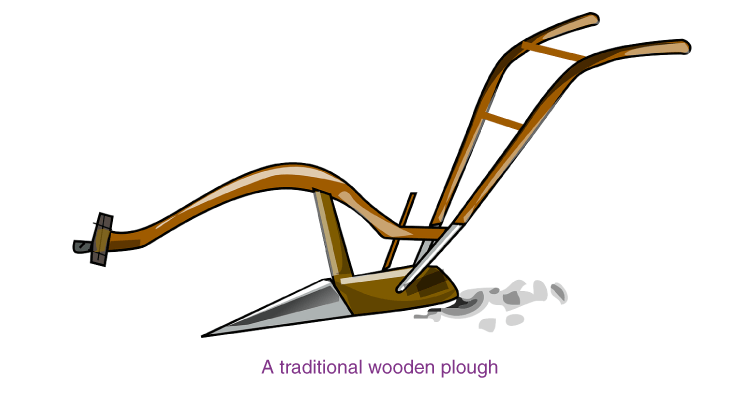
Hoe
A hoe is a tool that used to dig up soil to remove weeds and also loosen up the soil before planting a sapling.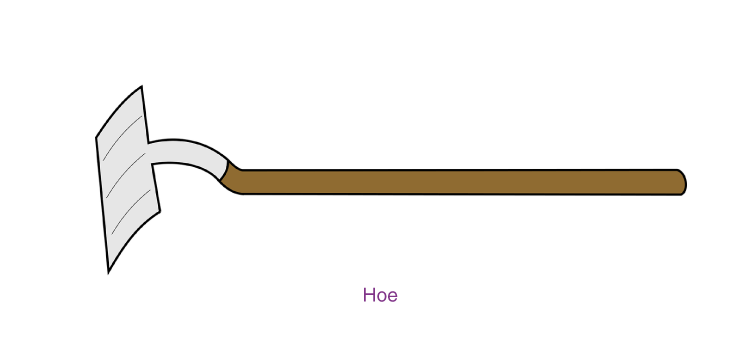
Cultivator
- A cultivator is attached to the tractor and helps in loosening soil.
- Cultivators are used instead of ploughs since they are faster.
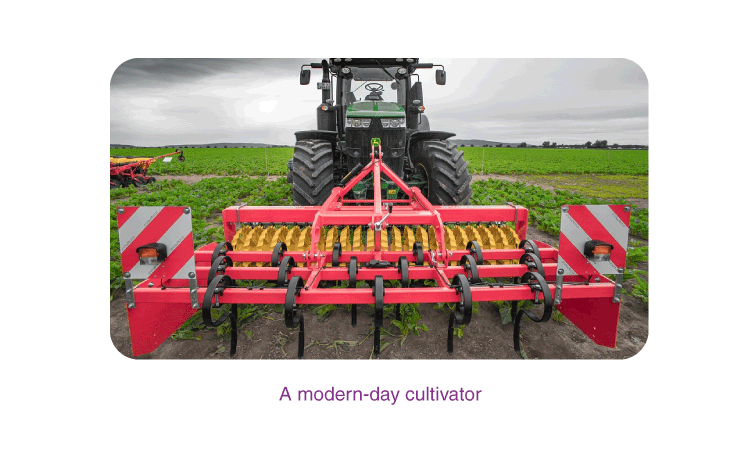
Leaving the Land Fallow
- When land is left fallow for a certain period of time, the land replenishes its nutrients by itself.
- This land can be used for agriculture again.
Crop Rotation
- Crop rotation ensures that the same crop will not grow continuously and lead to the erosion of the soil fertility.
- By growing crops that require different sets of nutrient, we can ensure the soil fertility is restored.
Protecting from Weeds
Weeds
Weeds are undesirable plants that may grow naturally along with the crop.
- Weeds compete with the crops by absorbing all the water, nutrients, space and light.
Tilling
- Tilling is a process done before sowing of crops that helps in uprooting and killing of weeds.
Manual Removal
- Manual removal includes physical removal of weeds by uprooting them from the soil or chopping them off to ground level periodically.
Weedicides
- Chemicals used to kill the weeds are known as weedicides.
- They usually don’t damage the crop.
Harvesting
- Harvesting is the process of cutting the crop after it is mature.
Methods of Harvesting
- Harvesting is done by 2 methods.
- First is the manual method where a sickle is used.
- Second is the mechanical method where a huge machine called harvester is used.
Threshing
- Threshing is the process of loosening the grains from the chaff.
- While it can be done manually, these days a machine is used that separates all the grain seeds.
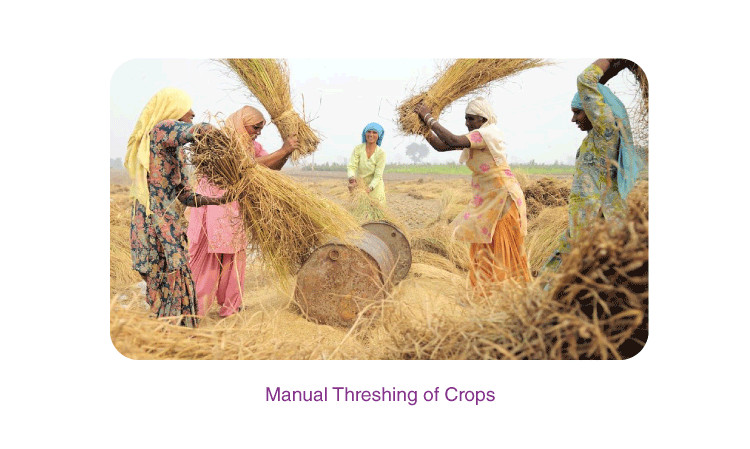
Winnowing
- Winnowing is the process of separation of grain seeds from the chaff using the help of the wind.
- Due to the wind, the lighter chaff flies away and the heavier grains fall down.
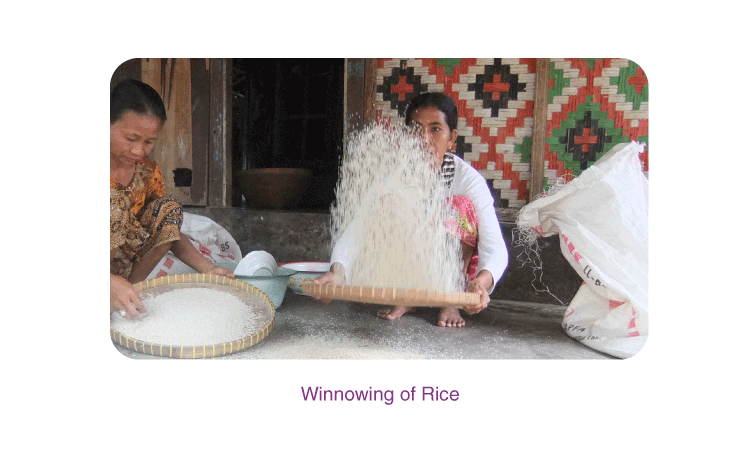
Storage
- Storage of the grains is an important step in agriculture.
- After harvesting steps, the ready grains are stored in granaries or silos.
- The grains have to be stored in a dry place that does not have a rodent or fungal infestation.
- Fumigation of storage places is carried out to make it free from microbes.
Granaries
- Granaries are the place where the freshly obtained food grains are stored.
Animal Husbandry
- Animal husbandry is the management and care of farm animals for milk, egg or meat.
Frequently asked Questions on CBSE Class 8 Science Notes Chapter 1: Crop Production and Management
What are the different types of irrigation methods?
The 4 main types of irrigation are: Surface, Sprinkler, Drip and Subsurface
What are biofertilizers?
Biofertilizers are living microbes that enhance plant nutrition by either by mobilizing or increasing nutrient availability in soils. Various microbial taxa including beneficial bacteria and fungi are currently used as biofertilizers, as they successfully colonize the rhizosphere, rhizoplane or root interior.
What is animal husbandry?
Animal husbandry is the branch of agriculture concerned with animals that are raised for meat, fibre, milk or other dairy products.
In Hindi Language
एनसीईआरटी चैप्टर 1 विज्ञान फसल उत्पादन और प्रबंधन क्लास 8 नोट्स सीबीएसई
 |
| एनसीईआरटी कक्षा 8 अध्याय 1 विज्ञान के नोट्स |
काटना
एक ही प्रकार के पौधे जो बड़े कृषि योग्य भूमि में भोजन के स्रोत के रूप में उगाए और उगाए जाते हैं, फसल कहलाते हैं।
फसलों के प्रकार
वे फसलें, जो शीत ऋतु (अक्टूबर से मार्च तक) में उगाई जाती हैं, रबी फसलें कहलाती हैं।
वे फसलें, जो वर्षा ऋतु (जुलाई से अक्टूबर तक) में बोई जाती हैं, खरीफ फसलें कहलाती हैं।
मिट्टी की तैयारी
- खाद्य उत्पादन के लिए फसल की खेती में मिट्टी की तैयारी पहला कदम है।
- फसल के बीज बोने के लिए मिट्टी तैयार की जाती है।
- यह विभिन्न प्रक्रियाओं और उपकरणों का उपयोग करके किया जाता है।
जुताई या जुताई
मिट्टी को ढीला करने और पलटने की प्रक्रिया को जुताई या जुताई कहते हैं और इसे हल से किया जाता है।
हल
- हल एक ऐसा उपकरण है जिसका उपयोग किसानों द्वारा विभिन्न उद्देश्यों के लिए किया जाता है जैसे कि उर्वरक डालना, जुताई करना और मिट्टी को ढीला करना।
- इसका उपयोग मिट्टी में खाद डालने, खरपतवार हटाने, मिट्टी को खुरचने आदि के लिए भी किया जाता है।
- हल का फाल लोहे की त्रिकोणीय पट्टी होती है।
- हल का मुख्य भाग हल का शाफ़्ट होता है, जो लकड़ी के लट्ठे का उपयोग करके बनाया जाता है।
- शाफ्ट के दूसरे सिरे पर एक हैंडल होता है।
- दूसरा सिरा एक बीम से जुड़ा होता है जिसे बैल की गर्दन पर रखा जाता है।
- एक लकड़ी, पारंपरिक हल को एक बैल और एक आदमी की जोड़ी द्वारा चलाया जा सकता है।
- आजकल इन लकड़ी के हलों का स्थान लोहे के हलों ने ले लिया है।

कुदाल
कुदाल एक ऐसा उपकरण है जो खरपतवार को हटाने के लिए मिट्टी को खोदता है और पौधा लगाने से पहले मिट्टी को ढीला भी करता है।
खेतिहर
- एक कल्टीवेटर ट्रैक्टर से जुड़ा होता है और मिट्टी को ढीला करने में मदद करता है।
- हल के स्थान पर कल्टीवेटर का प्रयोग किया जाता है क्योंकि वे अधिक तेज होते हैं।

भूमि परती छोड़ना
- जब भूमि को एक निश्चित अवधि के लिए परती छोड़ दिया जाता है, तो भूमि अपने पोषक तत्वों की पूर्ति अपने आप कर लेती है।
- इस भूमि का पुन: कृषि के लिए उपयोग किया जा सकता है।
फसल चक्र
- फसल चक्र यह सुनिश्चित करता है कि एक ही फसल लगातार नहीं उगेगी और इससे मिट्टी की उर्वरता का क्षरण होगा।
- विभिन्न प्रकार के पोषक तत्वों की आवश्यकता वाली फसलें उगाकर, हम यह सुनिश्चित कर सकते हैं कि मिट्टी की उर्वरता बहाल हो जाए।
खरपतवार से बचाव
मातम
खरपतवार अवांछित पौधे हैं जो फसल के साथ प्राकृतिक रूप से उग सकते हैं।
- खरपतवार सभी पानी, पोषक तत्व, स्थान और प्रकाश को अवशोषित करके फसलों के साथ प्रतिस्पर्धा करते हैं।
तिलिन्ग
- जुताई फसलों की बुवाई से पहले की जाने वाली एक प्रक्रिया है जो खरपतवारों को उखाड़ने और मारने में मदद करती है।
मैनुअल निष्कासन
- मैनुअल निष्कासन में खरपतवारों को मिट्टी से उखाड़कर या उन्हें समय-समय पर जमीनी स्तर पर काटकर भौतिक रूप से हटाना शामिल है।
खरपतवारनाशी
- खरपतवारों को मारने के लिए प्रयुक्त रसायन खरपतवारनाशी कहलाते हैं।
- वे आमतौर पर फसल को नुकसान नहीं पहुंचाते हैं।
फसल काटने वाले
- हार्वेस्टिंग फसल के पकने के बाद उसे काटने की प्रक्रिया है।
कटाई के तरीके
- कटाई 2 विधियों द्वारा की जाती है।
- पहली मैनुअल विधि है जिसमें दरांती का उपयोग किया जाता है।
- दूसरी यांत्रिक विधि है जिसमें हारवेस्टर नामक एक विशाल मशीन का उपयोग किया जाता है।
ताड़ना
- थ्रेशिंग भूसे से दानों को अलग करने की प्रक्रिया है।
- जबकि यह मैन्युअल रूप से किया जा सकता है, इन दिनों एक मशीन का उपयोग किया जाता है जो सभी अनाज के बीजों को अलग करती है।

सूप
- विनोइंग हवा की मदद से भूसी से अनाज के बीजों को अलग करने की प्रक्रिया है।
- हवा चलने से हल्की भूसी उड़ जाती है और भारी अनाज नीचे गिर जाता है।

भंडारण
- अनाज का भंडारण कृषि में एक महत्वपूर्ण कदम है।
- कटाई के चरणों के बाद, तैयार अनाज को अन्न भंडार या साइलो में संग्रहित किया जाता है।
- अनाज को एक सूखी जगह में संग्रहित किया जाना चाहिए जिसमें कृंतक या कवक का संक्रमण न हो।
- भंडारण स्थलों को कीटाणुओं से मुक्त करने के लिए धूमन किया जाता है।
अनाज का भंडार
- अन्न भंडार वह स्थान है जहां ताजा प्राप्त खाद्यान्नों का भंडारण किया जाता है।
पशुपालन
- पशुपालन दूध, अंडे या मांस के लिए खेत जानवरों का प्रबंधन और देखभाल है।
सीबीएसई कक्षा 8 विज्ञान नोट्स अध्याय 1: फसल उत्पादन और प्रबंधन पर अक्सर पूछे जाने वाले प्रश्न
सिंचाई के विभिन्न प्रकार कौन-कौन से हैं?
सिंचाई के 4 मुख्य प्रकार हैं: सरफेस, स्प्रिंकलर, ड्रिप और सबसर्फेस
जैव उर्वरक क्या हैं?
जैवउर्वरक जीवित सूक्ष्म जीव हैं जो मिट्टी में पोषक तत्वों की उपलब्धता को बढ़ाकर या बढ़ाकर पौधों के पोषण को बढ़ाते हैं। लाभकारी बैक्टीरिया और कवक सहित विभिन्न माइक्रोबियल टैक्स वर्तमान में जैव उर्वरक के रूप में उपयोग किए जाते हैं, क्योंकि वे राइजोस्फीयर, राइजोप्लेन या रूट इंटीरियर को सफलतापूर्वक उपनिवेशित करते हैं।
पशुपालन क्या है?
पशुपालन कृषि की वह शाखा है जो मांस, रेशे, दूध या अन्य डेयरी उत्पादों के लिए पाले जाने वाले पशुओं से संबंधित है।












0 Comments